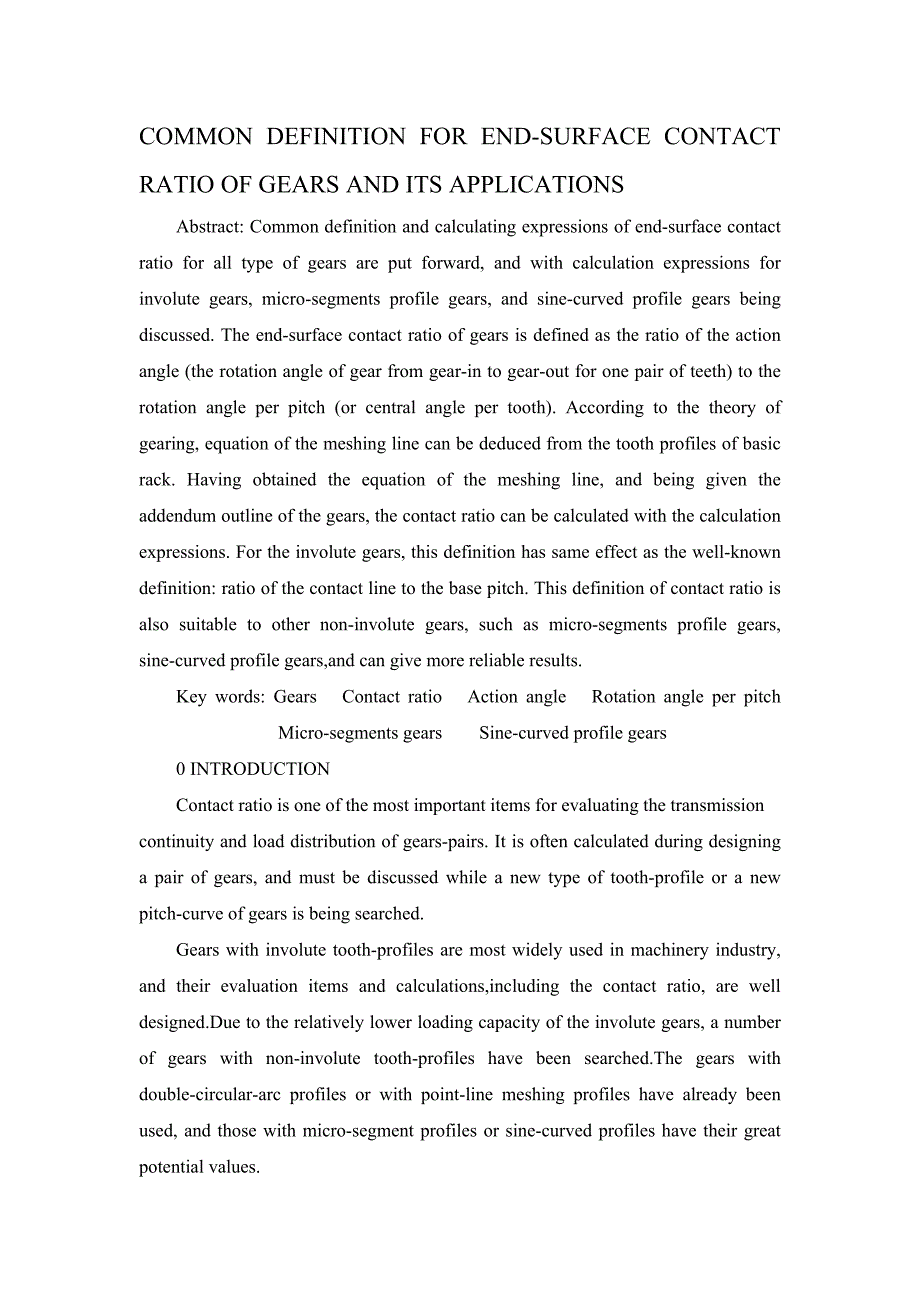资源预览内容
space
第1页 / 共15页
space
第2页 / 共15页
space
第3页 / 共15页
space
第4页 / 共15页
space
第5页 / 共15页
space
第6页 / 共15页
space
第7页 / 共15页
space
第8页 / 共15页
space
第9页 / 共15页
space
第10页 / 共15页
亲,该文档总共15页,到这儿已超出免费预览范围,如果喜欢就下载吧!
资源描述
COMMON DEFINITION FOR END-SURFACE CONTACT RATIO OF GEARS AND ITS APPLICATIONSAbstract: Common definition and calculating expressions of end-surface contact ratio for all type of gears are put forward, and with calculation expressions for involute gears, micro-segments profile gears, and sine-curved profile gears being discussed. The end-surface contact ratio of gears is defined as the ratio of the action angle (the rotation angle of gear from gear-in to gear-out for one pair of teeth) to the rotation angle per pitch (or central angle per tooth). According to the theory of gearing, equation of the meshing line can be deduced from the tooth profiles of basic rack. Having obtained the equation of the meshing line, and being given the addendum outline of the gears, the contact ratio can be calculated with the calculation expressions. For the involute gears, this definition has same effect as the well-known definition: ratio of the contact line to the base pitch. This definition of contact ratio is also suitable to other non-involute gears, such as micro-segments profile gears, sine-curved profile gears,and can give more reliable results.Key words: Gears Contact ratio Action angle Rotation angle per pitch Micro-segments gears Sine-curved profile gears0 INTRODUCTIONContact ratio is one of the most important items for evaluating the transmission continuity and load distribution of gears-pairs. It is often calculated during designing a pair of gears, and must be discussed while a new type of tooth-profile or a new pitch-curve of gears is being searched.Gears with involute tooth-profiles are most widely used in machinery industry, and their evaluation items and calculations,including the contact ratio, are well designed.Due to the relatively lower loading capacity of the involute gears, a number of gears with non-involute tooth-profiles have been searched.The gears with double-circular-arc profiles or with point-line meshing profiles have already been used, and those with micro-segment profiles or sine-curved profiles have their great potential values.The end-surface contact ratio of involute gears is defined as the ratio of meshing line to the base-pitch. This definition is not suitable for gears with non-involute tooth-profiles, as there are no real base-pitches in the gears with non-involute profiles.So, it is necessary to search a new common definition of the end-surface contact ratio applicable to gears with any type of tooth-profiles, and to work out calculation expressions under the new definition. In fact, the contact ratio can be considered as anindication of average teeth-pairs in mesh of a gear-pair, and naturally is ought to be detSned according to the rotation angle of a gear from gear-in to gear-out of a pair of teeth. Under this consideration, the calculation expressions for the end-surface contactratio of involute gears, micro-segment gears and sine-curved gears are put forward. Because of taking no account of axial contact ratio, the end-surface contact ratio is simply called contact ratio here.1 DEFINITION AND CALCULATION1.1 DefinitionIn common words, the contact ratio is an average number of teeth-pair in mesh at any time. Based on this consideration, it is defined as the ratio between the rotation angle of a gear from gear-in to gear-out of one pair of teeth to the rotation angle per pitch (rotation angle per tooth) of the same gear. The rotation angle of a gear during the period from gear-in to gear-out of one pair of teeth is called action angle of the gear, and the key-point to calculate the contact ratio is to obtain the value of the actionangle.According to the theory of gearing, when a pair of gears is in mesh, the common normal line at contact point (mesh point) of the two conjugate tooth profiles always passes through the pitch point. Locus of the mesh point relative to the pitch point iscalled the meshing line, and it is determined by tooth-profiles of the basic rack. All tooth profiles in application have some geometrical symmetry, the meshing line is an odd function passing though the pitch point. Intersecting point of the meshing line andthe addendum outline of gear becomes the gear-in point or gear-out point, when the mesh point is moving from the intersecting point to the pitch point, or from pitch point to the intersecting point, the rotation angle of the gear can be determined by using of the meshing line. All tooth profiles depend on their basic racks, and so do their meshing lines.1.2 Calculation expression Fig.1 shows gearing of tooth profiles 1 and 2. In the basic rack coordinate system Pxy, parametric equation of the meshing line 3 is as followsFig.1 Sketch diagram of gearing Rotating the gear slightly with micro angle d, making the meshing point move correspondingly with micro segment dl,thenTake unit value of module, i.e. m=l, and so do below. Because the basic rack is geometrically symmetric u
网站客服QQ:2055934822
金锄头文库版权所有
经营许可证:蜀ICP备13022795号 | 川公网安备 51140202000112号
